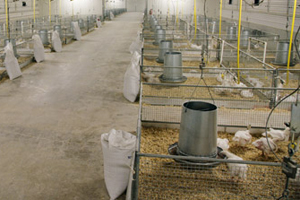NZ poultry producer claims lowest FCR

New Zealand poultry producer, Tegel Foods claims to have the lowest FCR in its production. The ratio for the company as a whole averages just 1:5 across its 90 or so contracted broiler farms, with a typical range from 1:45 to 1:65 at 2.3kg. Average processing weight is 2.5kg.
Agriculture manager Bill Williams says there are five key pillars, all of which have to be fine-tuned and optimised to deliver this performance. The first of these is genetic selection. “We are looking for a balance between production traits – low FCR, high meat yield and growth rate – and welfare traits, such as good leg strength and low mortality,” says Williams. “There is some trade-off in breeder performance for top broiler performance.”
The company has used the Ross breed exclusively since 1974. FCR has improved by 1.5 points each year for the past 10 years, and liveweights by 50g a year. Williams anticipates even bigger gains in genetic potential over the next five years.
The second pillar is nutrition and here Tegel Poultry is paying particularly close attention to feeding birds right in the early stages. “The first catch of female birds is at about 31 days, when they weigh 1.75kg, but as growth rate continues to improve over time, the starter diet becomes even more important.”
The company also uses a combination of EFG (Emmans, Fisher and Gous) modelling software, laboratory analysis, feeding trials and veterinary feedback to optimise its poultry rations. “The spec of the diet in protein and energy terms impacts directly on FCR, so the highest spec diet that can be managed in the shed at the optimum dressed weight cost to the plant is the objective.”
Getting the feed texture right is also important to maximise intakes with minimum effort for the bird. Feed procurement is an integral part of this strategy, with raw materials sourced to deliver this optimum outcome for the business. “Typically, New Zealand feed wheat is most cost effective for the Christchurch region, but is highly variable in quality,” says Mr Williams. “Imported wheat and sorghum from Australia, which tends to be more consistent in nutrient value, is used in our North Island plants, with soya bean meal typically sourced from South America.”
Dealing with high costs and volatility are a constant challenge, so the company routinely hedges both the currency and the commodity supply period. Volatility in terms of raw material quality is managed by pre-purchase and on-arrival testing, and by streaming the use of ingredients to manage in-feed nutrient levels.
The fourth pillar Tegel Poultry focuses on is disease control, though the company is blessed with New Zealand’s naturally low disease status. The country has no Infectious Bursal Disease, no Newcastle disease and no avian influenza. “There is nothing to vaccinate against.” The main challenges come from femoral head necrosis – “the most common cause of mortality” – coccidiosis and dysbacteriosis.
The final pillar is animal husbandry, covering everything from chick placement and planning, to shed management, biosecurity and grower attitude. Asked how he would define “best practice”, Williams says attention to detail in every aspect of the shed environment is the key to great performance. “The best growers typically spend more time in-shed assessing and managing the birds’ requirements than average growers.”
The company’s aim is to move any below-par producers closer to the top performers through a combination of shed improvement, training, support and better information availability, and so drive FCR lower still.
Source: Poultry World













